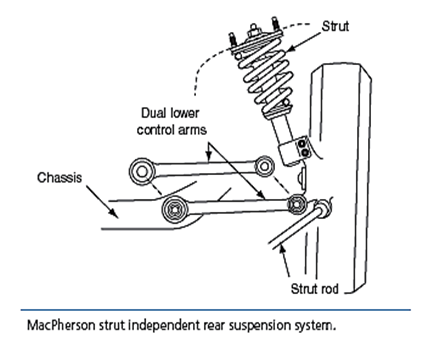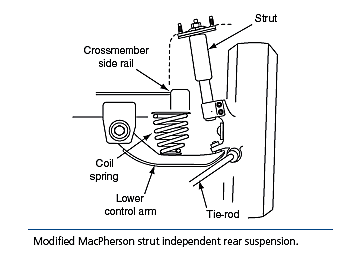Independent Rear Suspension Systems
Introduction:
In an independent rear suspension, vertical movement of one rear wheel does not affect the opposite rear wheel. In an independent rear suspension system, each rear wheel can move independently from the opposite rear wheel. Independent rear suspension systems may be found on front-wheel-drive and rear-wheel-drive vehicles. When rear wheel movement is independent, ride quality, tire life, steering control, and traction are improved.

MacPherson Strut Independent Rear Suspension System
- In a MacPherson strut rear suspension system, the coil springs are mounted on the rear struts.
- A lower spring seat is located on the strut, and the upper spring seat is positioned on the upper strut mount.
- This upper strut mount is bolted into the inner fender reinforcement. Dual lower control arms on each side of the suspension are connected from the chassis to the lower end of the spindle.
- The lower end of each strut is bolted to the spindle. Two strut rods are connected forward from the spindles to the chassis.
- Rubber insulating bushings are located in both ends of the strut rods. A stabilizer bar is mounted in rubber bushings connected to the chassis, and the ends of this bar are linked to the struts.
Modified MacPherson Strut Independent Rear Suspension System

- Some front-wheel-drive vehicles have a modified MacPherson strut independent rear suspension.
- Each side of the rear suspension has a shock strut, lower control arm, tie-rod, forged spindle, and coil spring mounted between the lower control arm and cross-member side rail.
Independent Rear Suspension with Lower Control Arm and Ball Joint:
Some front-wheel-drive cars have an independent rear suspension system with a ball joint pressed into the outer end of the lower control arm. The ball joint contains a conventional wear indicator. The upper end of the ball joint stud is bolted into the knuckle. The inner end of the lower control arm is connected to the chassis through two rubber insulating bushings.
